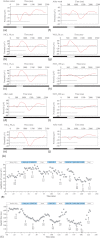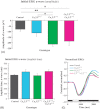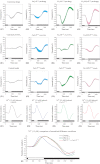Two separate Ni(2+) -sensitive voltage-gated Ca(2+) channels modulate transretinal signalling in the isolated murine retina
- PMID: 21883984
- PMCID: PMC3274955
- DOI: 10.1111/j.1755-3768.2011.02167.x
Two separate Ni(2+) -sensitive voltage-gated Ca(2+) channels modulate transretinal signalling in the isolated murine retina
Abstract
Purpose: Light-evoked responses from vertebrate retinas were recorded as an electroretinogram (ERG). The b-wave is the most prominent component of the ERG, and in the bovine retina its NiCl(2) -sensitive component was attributed to reciprocal signalling by pharmacoresistant R-type voltage-gated Ca(2+) channels, which similar to other voltage-dependent Ca(2+) channels trigger and control neurotransmitter release. The murine retina has the great advantage that the effect of gene inactivation for Ni(2+) -sensitive Ca(2+) channels can be analysed to prove or disprove that any of these Ca(2+) channels is involved in retinal signalling.
Methods: Superfused retinas from different murine genotypes lacking either one or both highly Ni(2+) -sensitive voltage-gated Ca(2+) channels were used to record their ex vivo ERGs.
Results: The isolated retinas from mice lacking Ca(v)2.3 R-type or Ca(v)3.2 T-type or both voltage-gated Ca(2+) channels were superfused with a NiCl(2) (15 μm) containing nutrient solution. The change in the b-wave amplitude and implicit time, caused by NiCl(2), was calculated as a difference spectrum and compared to data from control animals. From the results, it can be deduced that Ca(v)2.3 contributes rather to a later component in the b-wave response, while in the absence of Ca(v)3.2 the gain of Ni(2+) -mediated increase in the b-wave amplitude is significantly increased, probably due to a loss of reciprocal inhibition to photoreceptors. Thus, each of the Ni(2+)-sensitive Ca(2+) channels contributes to specific features of the b-wave response.
Conclusion: Both high-affinity Ni(2+)-sensitive Ca(2+) channels contribute to transretinal signalling. Based on the results from the double knockout mice, additional targets for NiCl(2) must contribute to transretinal signalling, which will be most important for the structurally similar physiologically more important heavy metal cation Zn(2+).
© 2011 The Authors. Acta Ophthalmologica © 2011 Acta Ophthalmologica Scandinavica Foundation.
Figures





Similar articles
-
A Ni(2+)-sensitive component of the ERG b-wave from the isolated bovine retina is related to E-type voltage-gated Ca(2+) channels.Graefes Arch Clin Exp Ophthalmol. 2005 Sep;243(9):933-41. doi: 10.1007/s00417-005-1145-6. Epub 2005 Apr 19. Graefes Arch Clin Exp Ophthalmol. 2005. PMID: 15838665
-
Effect of ZnCl2 and chelation of zinc ions by N,N-diethyldithiocarbamate (DEDTC) on the ERG b-wave amplitude from the isolated superfused vertebrate retina.Curr Eye Res. 2010 Apr;35(4):322-34. doi: 10.3109/02713680903509410. Curr Eye Res. 2010. PMID: 20373900
-
Antagonists of ionotropic gamma-aminobutyric acid receptors impair the NiCl2-mediated stimulation of the electroretinogram b-wave amplitude from the isolated superfused vertebrate retina.Acta Ophthalmol. 2009 Nov;87(8):854-65. doi: 10.1111/j.1755-3768.2008.01387.x. Acta Ophthalmol. 2009. PMID: 20002018
-
Voltage-gated Ca(2+) channel mediated Ca(2+) influx in epileptogenesis.Adv Exp Med Biol. 2012;740:1219-47. doi: 10.1007/978-94-007-2888-2_55. Adv Exp Med Biol. 2012. PMID: 22453990 Review.
-
Cardiac functions of voltage-gated Ca(2+) channels: role of the pharmacoresistant type (E-/R-Type) in cardiac modulation and putative implication in sudden unexpected death in epilepsy (SUDEP).Rev Physiol Biochem Pharmacol. 2014;167:115-39. doi: 10.1007/112_2014_21. Rev Physiol Biochem Pharmacol. 2014. PMID: 25280639 Review.
Cited by
-
Evaluation of micro Electroretinograms Recorded with Multiple Electrode Array to Assess Focal Retinal Function.Sci Rep. 2016 Aug 2;6:30719. doi: 10.1038/srep30719. Sci Rep. 2016. PMID: 27480484 Free PMC article.
-
Retinal Vessel Responses to Flicker Stimulation Are Impaired in Ca v 2.3-Deficient Mice-An in-vivo Evaluation Using Retinal Vessel Analysis (RVA).Front Neurol. 2021 Apr 13;12:659890. doi: 10.3389/fneur.2021.659890. eCollection 2021. Front Neurol. 2021. PMID: 33927686 Free PMC article.
-
Low concentrations of ethanol but not of dimethyl sulfoxide (DMSO) impair reciprocal retinal signal transduction.Graefes Arch Clin Exp Ophthalmol. 2015 Oct;253(10):1713-9. doi: 10.1007/s00417-015-3070-7. Epub 2015 Jun 25. Graefes Arch Clin Exp Ophthalmol. 2015. PMID: 26104874
-
Unconjugated bilirubin modulates neuronal signaling only in wild-type mice, but not after ablation of the R-type/Cav 2.3 voltage-gated calcium channel.CNS Neurosci Ther. 2018 Mar;24(3):222-230. doi: 10.1111/cns.12791. Epub 2017 Dec 23. CNS Neurosci Ther. 2018. PMID: 29274300 Free PMC article.
-
Submicromolar copper (II) ions stimulate transretinal signaling in the isolated retina from wild type but not from Cav2.3-deficient mice.BMC Ophthalmol. 2020 May 6;20(1):182. doi: 10.1186/s12886-020-01451-8. BMC Ophthalmol. 2020. PMID: 32375703 Free PMC article.
References
-
- Albanna W, Banat M, Albanna N, et al. Longer lasting electroretinographic recordings from the isolated and superfused murine retina. Graefes Arch Clin Exp Ophthalmol. 2009;247:1339–1352. - PubMed
-
- Ball SL, Gregg RG. Using mutant mice to study the role of voltage-gated calcium channels in the retina. Adv Exp Med Biol. 2002;514:439–450. - PubMed
-
- Barnes S, Kelly ME. Calcium channels at the photoreceptor synapse. Adv Exp Med Biol. 2002;514:465–476. - PubMed
-
- Bech-Hansen NT, Naylor MJ, Maybaum TA, et al. Loss-of-function mutations in a calcium-channel a1-subunit gene in Xp11.23 cause incomplete X-linked congenital stationary night blindness. Nat. Genet. 1998;19:264–267. - PubMed
-
- Catterall WA. Structure and regulation of voltage-gated Ca2+ channels. Annu. Rev. Cell Dev. Biol. 2000;16:521–555. - PubMed
Publication types
MeSH terms
Substances
Grants and funding
LinkOut - more resources
Full Text Sources
Miscellaneous

